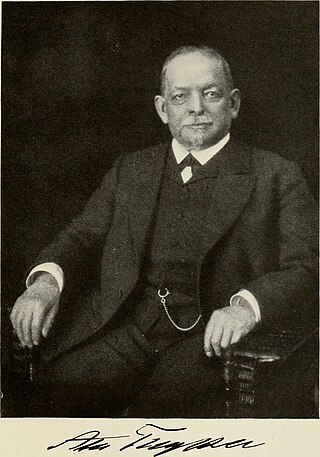The merger of four major firms into the German Steel Trust in 1926 was modeled on the U.S. Steel corporation in the U.S. The goal was to move beyond the limitations of the old cartel system by incorporating advances simultaneously inside a single corporation. The new company emphasized rationalization of management structures and modernization of the technology; it employed a multi-divisional structure and used return on investment as its measure of success. it represented the "Americanization" of the German steel industry because of its internal structure, management methods, use of technology, and emphasis on mass production replicated the Steel Trust developed a multi-divisional structure and aimed at return on investment as a measure of success. The chief difference was that consumer capitalism as an industrial strategy did not seem plausible to German steel industrialists.

Friedrich "Fritz" Thyssen was a German businessman, born into one of Germany's leading industrial families. He was an early supporter of the Nazi Party but later broke with it.

ThyssenKrupp AG is a German industrial engineering and steel production multinational conglomerate. It resulted from the 1999 merger of Thyssen AG and Krupp and has its operational headquarters in Duisburg and Essen. The company says that it is one of the largest steel producers in the world, and it was ranked tenth-largest worldwide by revenue in 2015. It is divided into 670 subsidiaries worldwide. The largest shareholders are the Alfried Krupp von Bohlen und Halbach Foundation and Cevian Capital. ThyssenKrupp's products range from machines and industrial services to high-speed trains, elevators, and shipbuilding. The subsidiary ThyssenKrupp Marine Systems also manufactures frigates, corvettes, and submarines for the German and foreign navies.

The Thyssen family has notable members, all of whom descend from Friedrich Thyssen, who have established steel works, elevators and escalators, industrial conglomerates, banks, and art collections - Thyssen AG, ThyssenKrupp and ThyssenKrupp Marine Systems. Originating from Germany, family members have taken up residence in various countries.

August Thyssen was a German industrialist, founder and controlling shareholder of Thyssen & Co. He was a prominent member of the Thyssen family.

Georgsmarienhütte is a town in the district of Osnabrück, in Lower Saxony, Germany. It is situated in the Teutoburg Forest, approx. 7 km south of Osnabrück.

Albert Vögler was a German politician, industrialist and entrepreneur. He was a co-founder of the German People's Party, and an important executive in the munitions industry during World War II.

Emil Kirdorf was a German industrialist, one of the first important employers in the Ruhr industrial sectors. He was personally awarded by Adolf Hitler the Order of the German Eagle, Nazi Germany's highest distinctions, on his 90th birthday in 1937, for his support to the Nazi Party in the late 1920s.

Thyssen was a major German steel producer founded by August Thyssen. The company merged with Friedrich Krupp AG Hoesch-Krupp to form ThyssenKrupp in 1999.
Walter Rohland was a German industrial leader during World War II. In 1916, during World War I, Rohland joined the engineering corps as a teenage volunteer. Rohland worked was chief engineer for the company Bochumer Verein headed by Walter Borbet (1881–1942). Borbet's company had pioneered the introduction of low-cost gun steels in World War I. In the 1920s Bochumer Verein became one of the centers for the development of centrifugal casting, a revolutionary process in which gun barrels, rather than being bored out of solid steel ingots, were spun out of molten metal. From 1940 to 1943, Rohland was chief of the Deutsche Edelstahlwerke Krefeld, a leading supplier of armour plating. From 1943 to 1945, Rohland was head of the giant Vereinigte Stahlwerke complex. He also served on the main German tank production coordinating committee.
Ruhrgas AG was the largest natural gas transportation and trading company based in Essen, Germany. The company was founded in 1926 and it finally ceased to exist on 2 May 2013 when it was merged into E.ON Global Commodities SE.

Salzgitter AG is a German company, one of the largest steel producers in Europe with an annual output of around seven million tonnes.
The Industrielleneingabe was a petition signed by 19 representatives of industry, finance, and agriculture on November 19, 1932 that requested for German President Paul von Hindenburg to make Adolf Hitler the German Chancellor.

The Eisenbahn und Häfen GmbH is a service company providing rail transportation and associated storage as well as operating the Rhine ports of Schwelgern and Walsum-Süd.

A Wehrwirtschaftsführer was, during the time of Nazi Germany (1933–1945), an executive of a company or of a large factory. Wehrwirtschaftsführer were appointed, starting in 1935, by the Wehrwirtschafts und Rüstungsamt being a part of the Oberkommando der Wehrmacht (OKW), that was pushing the build-up of arms for the Wehrmacht. Appointments aimed to bind the Wehrwirtschaftsführer to the Wehrmacht and to give them a quasi-military status.

(Justus) Henning von Boehmer is a German author, publisher, lawyer, and journalist in Germany, particularly Düsseldorf.
Rothe Erde is a district of Aachen, Germany with large-scale development in heavy industry. It is sub-district 34 of the Aachen-Mitte Stadtbezirk. It lies between the districts of Forst and Eilendorf.
Oscar Schlitter was a German banker. Reflecting the long-standing "hands-on" approach of banks in Germany, Schlitter was involved in several major commercial and industrial mergers. He played a leading role in the 1929 merger of the indebted German VGF company with the Dutch ENKA business, creating one of the leading European producers of rayon.
Peter Klöckner was a German businessman and industrialist.

The Deutsch-Luxemburgische Bergwerks- und Hütten-AG sometimes abbreviated as DL was one of the largest vertically integrated mining conglomerates in Germany at the beginning of the 20th century. Its headquarters was located in Bochum.














